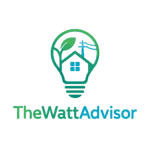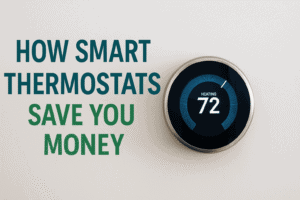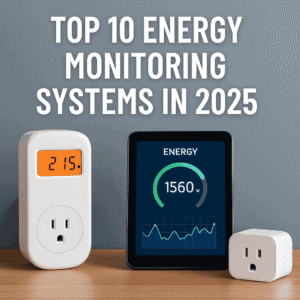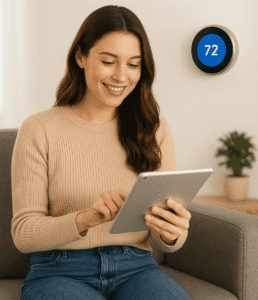Top 5 Smart Plugs for Energy Savings
Looking for the best smart plugs to save energy, lower your electricity bills, and simplify your daily routines? You’re in the right place.
Welcome to The Watt Advisor, where energy efficiency meets smart living. In this comprehensive guide, we dive into the best smart plugs that can help transform your home into an intelligent and energy-conscious space. Whether you’re a smart home beginner or a seasoned automation enthusiast, choosing the best smart plugs can play a significant role in optimizing your home’s energy usage without requiring any major upgrades or replacements.
The best smart plugs allow you to control your appliances remotely, schedule on/off times, and monitor energy usage in real time. Many models now include energy monitoring features, voice assistant compatibility (like Alexa, Google Assistant, or Siri), and even Matter support for universal interoperability. What makes the best smart plugs even more appealing is their affordability and ease of use, you just plug them in, connect to your app, and start saving energy from day one.
In this detailed post, we’ll walk you through:
- How smart plugs work and why they’re essential for energy efficiency
- What to look for when choosing the best smart plugs for your home
- In-depth reviews of our top 5 smart plug picks in 2025
- Pros, cons, and use cases for each model
- Practical tips to maximize energy savings with smart plug automations
By the end of this guide, you’ll not only discover the best smart plugs for your setup, but also understand how to fully integrate them into your lifestyle for maximum energy savings. Let’s plug into smarter living with confidence!
Why Smart Plugs Save Energy
Smart plugs act as switchable, monitored outlets that can be controlled remotely via app or voice. They deliver energy savings in several ways:
- Remote shut‑off: Turn off devices left on accidentally, eliminating phantom power.
- Scheduling: Automate power cycles e.g., turning off holiday lights at night.
- Energy monitoring: Track real-time device usage; identify power hogs.
- Routines & Scenes: Bundle actions (turn off TV, lamp, fan) with one tap.
- Automation: Integrate with sensors e.g., auto-off when leaving a room.
The result? Cut standby loads and ensure energy isn’t wasted when devices are not needed. According to The Spruce, users cutting idle loads can save $15/month per smart plug pair.
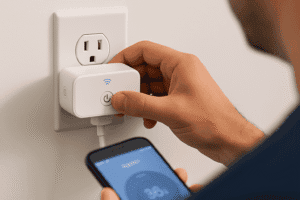
Key Features to Consider
Before diving into reviews, here’s what really matters:
- Energy Monitoring: Gauges actual kWh usage and cost estimates.
- App & Ecosystem: Works with Alexa, Google, HomeKit, Matter, SmartThings.
- Physical Size: Compact design avoids blocking neighboring outlets.
- Protocols & Connectivity: Wi‑Fi, Bluetooth, Thread, Matter reliability.
- Automation Capabilities: Away modes, schedules, timers, overload protection.
We rate each plug on these criteria below.
Insiders’ Picks—Top 5 Smart Plugs
1. TP‑Link Kasa KP125M (Energy Monitoring)
The TP-Link Kasa KP125M stands out as one of the most feature-rich and reliable smart plugs for energy-conscious households. Built with Matter compatibility, it ensures seamless integration with major ecosystems like Apple HomeKit, Google Assistant, Amazon Alexa, and Samsung SmartThings. Its compact design ensures adjacent outlets remain accessible, ideal for tight spaces or power strips.
The true strength of the KP125M lies in its real-time energy monitoring. Through the Kasa Smart app, users can view detailed consumption data, estimate electricity costs, and identify wasteful appliances. This empowers homeowners to make data-driven decisions about which devices should be run, unplugged, or scheduled. For those seeking better control, the plug allows customizable schedules, away modes, and voice-activated commands.
Another pro is its robust build quality and reliable connectivity. The KP125M uses Wi-Fi without the need for an additional hub, which reduces setup complexity. Plus, TP-Link’s reputation for stable firmware updates ensures longevity.
Pros:
- Full energy monitoring and reporting
- Matter-compatible for future-proofing
- Works with all major voice assistants
- Compact and easy to install
- Remote and scheduled controls
Cons:
- Slightly pricier than non-monitoring plugs
- Advanced features require app access
In summary, if you’re serious about optimizing your energy usage and want smart analytics, the TP-Link Kasa KP125M is a top-tier choice in 2025.
2. Eve Energy Smart Plug
The Eve Energy Smart Plug is a premium device designed specifically for Apple HomeKit users. It excels in security, ease of use, and energy data transparency. With Thread and Matter support, Eve ensures ultra-low latency and consistent responsiveness—two major selling points in modern smart home networks.
One of the best features is the detailed energy consumption analysis. You can track current, voltage, and total power usage through the Apple Home app or Eve’s proprietary app. This is especially useful for homeowners who want to reduce phantom energy drain or track long-term appliance consumption.
Eve Energy is also privacy-focused, no cloud connection is required, meaning your data stays local and secure. This is a rarity in smart plugs and a huge plus for users concerned about cybersecurity.
Pros:
- Excellent for Apple HomeKit and iOS users
- Detailed power metrics (kWh and real-time watts)
- Secure and privacy-friendly (no Eve cloud required)
- Thread support for faster, more reliable automation
- Compact build fits snugly in most outlets
Cons:
- Not compatible with Alexa or Google Home
- Slightly expensive compared to multi-platform plugs
If you’re an Apple-centric household and value data privacy and advanced energy monitoring, Eve Energy is an outstanding choice.
3. Wemo Insight Smart Plug
The Wemo Insight Smart Plug has long been a go-to product for energy-conscious users seeking straightforward control. Built with energy monitoring features, it allows users to track energy use over time and sends real-time reports to the Wemo app.
This smart plug is compatible with Alexa, Google Assistant, and Apple HomeKit, giving it broad appeal. The “Away Mode” is a notable feature, it turns lights on/off randomly to simulate occupancy while you’re away, which can help with home security as well as energy savings.
Its integration with IFTTT opens up even more possibilities for automation and personalized routines. For example, it can turn off a space heater automatically when your phone leaves the home Wi-Fi range.
Pros:
- Real-time energy monitoring
- IFTTT support for advanced automation
- Works with Alexa, Google, and HomeKit
- Compact and easy to set up
- Trusted brand with years of reliability
Cons:
- App interface feels outdated
- Doesn’t support Matter or Thread
- Occasional connection drops reported
Overall, the Wemo Insight is a solid mid-tier choice with reliable performance and useful automation features.
4. Meross Matter Smart Plug Mini
Meross Smart Plug Mini is a fantastic budget-friendly plug with modern capabilities. With Matter support, it integrates seamlessly across platforms including Alexa, Google Home, and Apple HomeKit. Despite being compact and affordable, it doesn’t compromise on speed or features.
Though it lacks energy monitoring, Meross shines with ultra-fast response times, scene automation, and voice control. You can schedule power on/off, set routines, and remotely control any plugged-in appliance using your preferred smart assistant. This is ideal for lamps, coffee makers, or even routers.
Its two-pack or four-pack bundles offer excellent value, making it perfect for users looking to automate multiple outlets at once without breaking the bank.
Pros:
- Matter-compatible for broad compatibility
- Extremely affordable and compact
- Easy to install and use
- Reliable performance for automation
- Perfect for basic smart control needs
Cons:
- No energy usage tracking
- Limited advanced features
- App interface is functional but not very polished
In essence, Meross Smart Plug Mini is perfect for users just starting with smart home setups or those wanting basic automation at a great price.
5. Govee Smart Plug (4-Pack)
The Govee Smart Plug (4-Pack) offers excellent value for homeowners who want to automate multiple devices. These plugs work with Alexa and Google Assistant, and while they don’t support Matter yet, they are highly responsive and intuitive.
Govee has built a reputation for user-friendly setup and fast operation. Through the Govee Home app, users can schedule appliances, create groups, and monitor usage statistics (only available in some models). Though it lacks advanced analytics, it’s great for users who want to reduce vampire energy loads or automate lighting.
One highlight is the plug’s group control. You can set multiple plugs to turn off/on at once, perfect for managing a home office, holiday lighting, or entertainment setups.
Pros:
- Budget-friendly multi-pack bundle
- Supports group control and schedules
- Works with Alexa and Google
- Reliable Wi-Fi connection
- Easy setup and app usability
Cons:
- Lacks detailed energy analytics
- No support for Apple HomeKit or Matter
- Slightly bulkier design than some competitors
For those looking to automate multiple appliances efficiently without a big investment, Govee’s Smart Plug 4-Pack is a top pick.
Comparison Table
| Plug | Energy Monitor | Ecosystem | Size | Approx $ |
|---|---|---|---|---|
| TP‑Link Kasa KP125M | Yes | Alexa, Google, Home, Matter | Compact | $25–40 |
| Eve Energy | Yes | HomeKit, Thread, Matter | Slim | $40–50 |
| Wemo Insight | Yes | Alexa, Google, HomeKit | Medium | $30–45 |
| Meross Mini | Yes | Alexa, Google, HomeKit, Matter | Small | $20–30 |
| Govee (4‑Pack) | Yes | Alexa, Google | Compact | $35–45 |

Setup & Best‑Use Tips
- Plug in and pair using the manufacturer app.
- Configure schedules: off at bedtime, on at sunrise, etc.
- Enable away mode for added security and unpredictability.
- Monitor/compare energy usage weekly via app graphs.
- Use automations: e.g., motion-controlled lamp usage.
- Protect devices: set usage thresholds or overload protection.
- Group smart plugs in the app for power-down routines (morning, vacation, etc.)
Which Smart Plug is Right for You in 2025?
Choosing the best smart plugs for energy savings depends on your ecosystem, budget, and goals. Here’s a breakdown:
- Choose TP-Link Kasa KP125M if you want Matter support + energy monitoring and compatibility across all platforms.
- Go for Eve Energy if you’re deeply invested in the Apple ecosystem and want superior data privacy and tracking.
- Select Wemo Insight for reliable automation and IFTTT support, ideal for users seeking customization.
- Try Meross Mini for affordable, Matter-compatible automation, perfect for smart home beginners.
- Opt for Govee (4-pack) if you need to control multiple devices affordably and aren’t concerned with power tracking.
Each of these smart plugs offers unique advantages. When used strategically, they can significantly reduce energy waste, increase efficiency, and provide remote convenience, proving that the best smart plugs aren’t just about convenience, but also cost and energy savings.
FAQs
What makes a smart plug one of the best smart plugs for energy savings?
The best smart plugs combine reliable energy monitoring, scheduling or automation, and compatibility with major ecosystems (Alexa, Google, HomeKit, Matter), along with a compact design and safety features like auto shut‑off.
Can a smart plug really save money on my electricity bill?
Yes—by eliminating standby power, automating off‑peak usage, and alerting you to inefficient devices, smart plugs can save $10–20 per month per device. Over time, these savings easily offset the cost of the plug.
Are smart plugs secure and private?
Look for plugs that support local control (like Eve Energy or Matter-enabled devices). Always use secure Wi‑Fi, update firmware, and avoid obscure brands to maintain privacy and security.
How do I choose between these top smart plugs?
Choose based on your ecosystem (e.g., HomeKit users go for Eve; cross-platform users for TP‑Link), desired energy analytics, physical size, and budget—Meross and Govee offer strong value for money.
Other Related Posts on TheWattAdvisor
- Learn about smart thermostats: How Smart Thermostats Save You Money
- Explore other energy-saving devices: Top 5 Energy-Efficient Appliances
- Conduct your own energy audit: DIY Home Energy Audit Checklist
This post was on Top 5 Best Smart Plugs in 2025.
